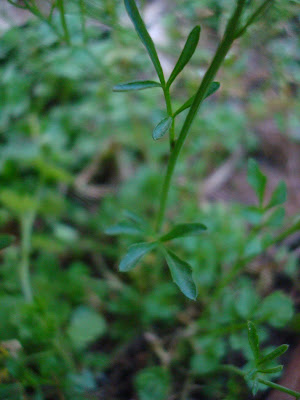
Bittercress:
-Starts blooming mid to late winter, or earlier depending on location
-Flowers in clusters at the top of stalks, each with four white petals
-Conspicuous seedpods clustered along and further down the stem
One of the first flowers to emerge during the cold of winter is Bittercress. If you're noticing little tiny white flowers appearing on stalks rising several inches off the ground in mid to late winter, it's probably Bittercress, and if you're in the Eastern US and it's Bittercress you're seeing, it's probably the variety called Hairy Bittercress. Or... Pennsylvania Bittercress. The problem is, it's really difficult to tell the difference between some Bittercress varieties- and these two varieties in particular- since their appearance is similar. There are actually several species of Cardamine that look so much alike, a casual observation would not be able to distinguish between them. But it's really not that important to the amateur to fine tune this identification; just tell your friends that 'weed' springing up in their yard is called Bittercress.


There is, however, one distinction that might be important for the amateur: between the two most common Bittercress varieties (Pennsylvania and Hairy), the former is native but the latter is introduced. This distinction doesn't prevent either variety from growing rampantly in disturbed areas, gardens left abandoned for the winter, yards, curbsides, and yes, cracks in the pavement. Cress, interestingly, is another word for 'salad', so you could be reasonably confident that these members of the mustard family- and relatives to watercress- were once used as a green in a forager's salad.
If you're still having trouble deciding if you're looking at Bittercress, one of the most conspicuous traits of the annual plant is its seedpods. While green, they form up in ranks along the stalk underneath the flowering head like very miniature pea pods. But when brown, watch out for a surprise! Using mechanical action, the spring-loaded pods will explode suddenly if even slightly disturbed, scattering the seeds across your yard or garden. Take a young child out to a Bittercress patch and see if the young one can manage to relight for you any excitement in a common weed. ...But... if necessary, catching the pods while green should allow for safe diffusing.

Notice how the leaves are rounded close to the ground, but can be pointed, angular, or even vary narrow further up along the stem.



No comments:
Post a Comment